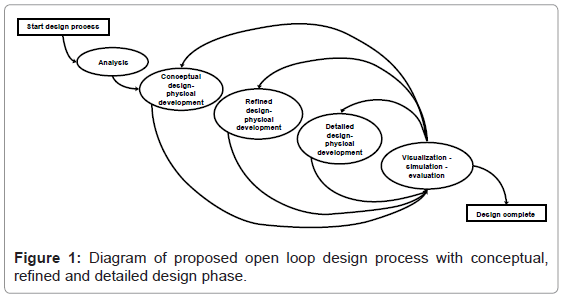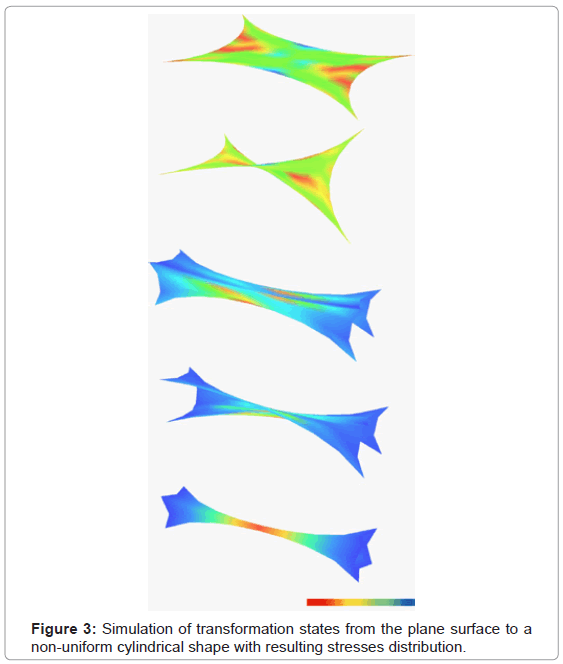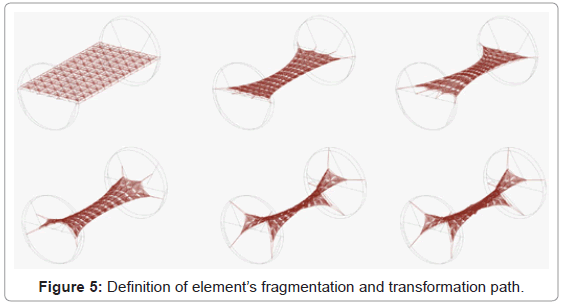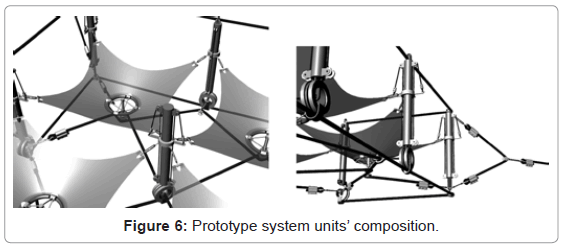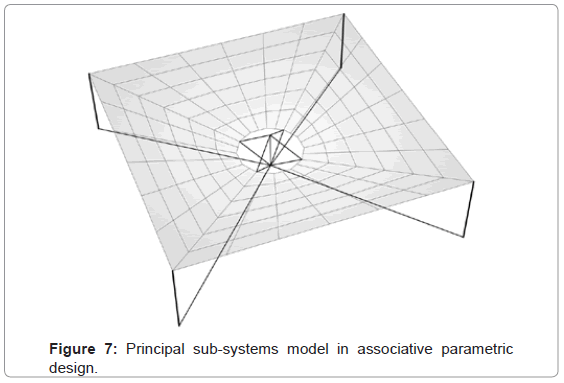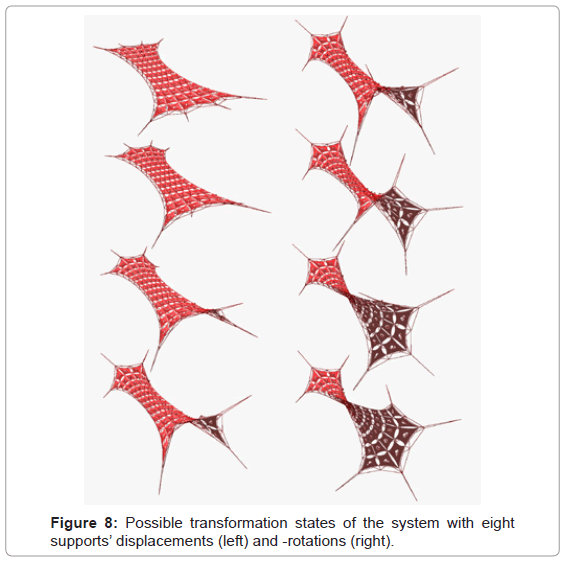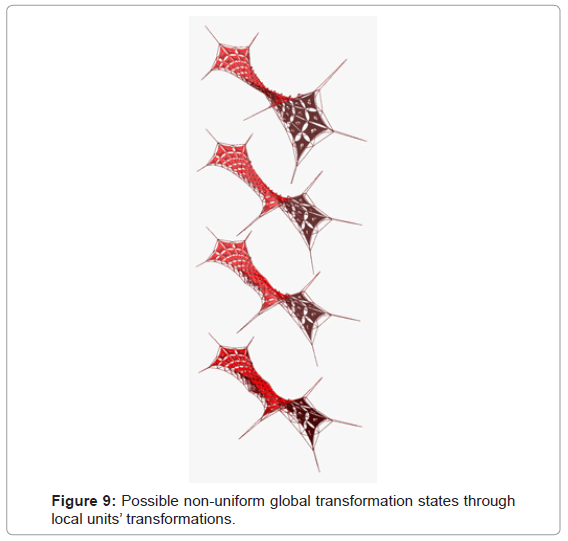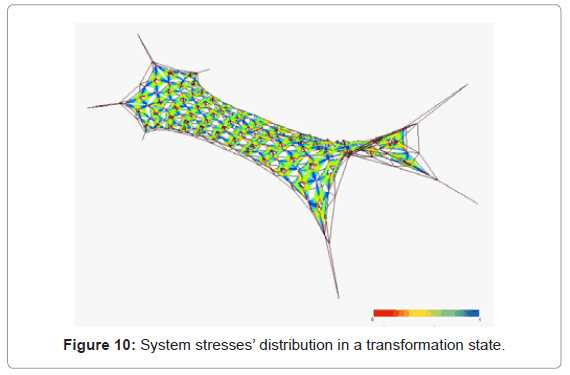Interdisciplinary Research-based Design: the Case of a kinetic form-active Tensile Membrane
Received: 18-Jul-2012 / Accepted Date: 19-Nov-2012 / Published Date: 26-Nov-2012 DOI: 10.4172/2168-9717.1000104
Abstract
In the last years it is increasingly acknowledged that advances in digital technology are paving the way to achieve integrated interdisciplinary design, a type of practice that covers a mindset of collaboration and cross-disciplinary communication and experimentation, visualization and research at all stages of the architectural design process. Along these lines interdisciplinary research is necessary to engage complex topics that bridge between design and engineering. An open loop design methodology of interdisciplinary physical and digital investigations from the conceptual development up to the detailed physical prototyping is proposed in the current paper. The approach is exemplified with the design of a kinetic form-active membrane system. Membrane surfaces comprise the basic component of the hybrid system developed, whereas any form modification is activated through the system’s cablenet and struts. The interactive platform of investigation, based on physical- and digital modelling serves for the definition of the system’s adaptability, its composition and the structural components design.
Keywords: Interdisciplinary research; Digital modelling
73529Introduction
Developments in digital design technology currently applied in the architectural and engineering design fields enable the extension of design processes from the conceptual phase to development and fabrication. Complex architectural forms are often realized in linear digital processes through technology transfer and material advancements. In this frame architectural design often prioritizes predominantly form over its subsequent materialization, construction and manufacture, leading to top-down engineered, often non-optimized solutions [1]. At the same time structural engineering has experienced a phase of integration, primarily through the development and application of numerical calculation methods such as finite-element analysis. It may be stated that the latter field has shifted into a science of simulations that are distanced from the actual construction and structure of the building, while these are increasingly being defined by abstract symbols [2].
In parallel contemporary design approaches gradually acknowledge that architecture encompasses a number of disciplines, bringing together a number of distinct modes of research and types of knowledge [3]. Research into architecture is becoming conscious of these interactions and of the particular need for architectural knowledge and practice to be non-linear and integrative across disciplinary boundaries. Design provides possibilities for interdisciplinary research, through an integrative approach to education and practice, while also crossing traditional research areas. Recent advances of disciplines, specialization, materials, system science and digital data driven computation have brought a radical change in the contextual frameworks in which architectural design and production are normally placed. Such advances have been paving the way to achieve ‘integrated inter, multi or even transdisciplinary design’, in all cases a type of practice that covers a mind-set of collaboration and cross disciplinary communication and experimentation, visualization and research throughout the design process.
A consideration of the inherent morphological and performative capacities of any design schemes and their employed material systems may lead to a re-integration of design and analysis in physical and digital environments [4]. In this frame, the integrative development of form, structure and construction is of particular significance. Earlier architectural examples in this direction constitute, among others, the works of Robert Maillart, Eduardo Torroja, Pier Luigi Nervi, Antoni Gaudi and Frei Otto. Along these lines architecture may be interpreted as an interdisciplinary research-based design process.
In this context, lightweight structures especially stand out as an exemplary field that revolutionized architectural technology and engineering in the early 70’s, while having established new conditions and methodologies regarding cooperation between architectural and engineering disciplines in practice and research [5]. Membranes and cable-nets are considered as form-active tension systems [6]. Structurally such systems shape according to the applied forces into minimal surfaces, i.e. double-curved saddle-shape or anticlastic surfaces. For these structures, form, construction and stress distribution are conditioned reciprocally. The design geometry is revised in an iterative process of form-finding, as long as the equilibrium form under the imposed stress requirements of the members and boundary conditions has been reached.
In parallel to the development of lightweight structures, Buckminster Fuller demonstrated already through “Ephemeralization” reduction of material [7]. In this aspect, Robert Kronenburg illustrates the advantage of buildings that use fewer resources and adapt efficiently to complex site and programmatic requirements of particular relevance to the construction industry’s environmental responsibilities [8]. This specific point is addressed by the majority of adaptable lightweight structures that enable through their transformability by folding, sliding and/or expanding the interchange of functional conditions of the building. Realized project examples are foldable PTFE-membrane structures [9]. The foldable textile roof for the Commerzbank-Arena in Frankfurt completed in 2005 by von Gerkan, Marg & Partner and Schlaich, Bergermann & Partner, arguably the largest structure of this type in the world measuring 113×78 m, and the retractable textile roof of the free theatre arena Josefsburg built in 2006 at the Fortress Kufstein, Austria by Kugel and Rein, are clear examples of a folding architecture on the basis of flexible materials [10]. A significant step towards the development of kinetic lightweight structures was achieved at VUB, Brussels in 2003 with a deployable membrane supported on two scissor columns [11]. The prototype investigations included initial computer simulations for the load distribution within the transformable structure and verification of the numerical results in the laboratory.
Experimental investigations on concepts of adaptive membrane systems are based on physical models combined with parametric associative digital design- and 3D graphical techniques. Representative project examples are the Membrane Morphologies 02 installed at the Architectural Association, London, in 2004 by Hensel and Menges and the Architectural Association membrane canopy realized in 2007 by the Emergent Technologies and Design Group in collaboration with the Buro Happold [12,13]. In parallel research-based design projects with elastic membranes, supervised by Hensel and Menges at the Rotterdam Academy of Architecture and Urban Design and the Architectural Association in 2005 and 2006 respectively, investigated the application of digital processes for complex performative arrangements of elastic membranes and multivariable morphologies [14].
Design may be informed and enriched at every stage of development by the knowledge acquired through research. Such research-based design processes entail elaboration and discovery and facilitate design creativity. The methodology of research-based design is discussed in the following section and an open loop design process is proposed and further elaborated with a case example of a form-active tensile membrane. The particular case example required an iterative feedback loop of integrated physical and computational design.
Research-based design
Each phase of the design employs information, knowledge, theory, or techniques from other disciplines, which the design team may select as being relevant to the task on hand [15]. The acquisition of given knowledge is not viewed as an educational end in itself but rather a learning process. Such an experiential learning process according to Kolb can be defined as a mode of learning in which knowledge results from a combination of grasping and transforming experience in a four phase virtuous learning cycle that comprises concrete experience, reflective observation, abstract conceptualisation and active experimentation [16]. Along these lines the design process is no-longer viewed as a linear problem solving activity, whereas sequential activities are carried out in a linear order, as for example problem definition, analysis, synthesis and evaluation, since there is no direct flow from one activity to another [17-19]. In this respect, an open structure in the synthetic process that forms the core of the design process has been proposed in [20], in which phases are grouped in a circular arrangement, yet the process itself does not develop in a linear manner. In an explorative design process, knowledge may be transferred through the decision-making design process–research-based knowledge–while each intermediate design result may as well lead to new knowledge inquiry and acquisition– design-driven knowledge. In other words, designers employ knowledge from research and generate new it erations throughout the design process that develops new hypotheses and visions. Research into architecture thus has to be conscious of interactions across traditionally separate intellectual fields, which according to Lawson can be divided into three stages: architectural processes, architectural products and architectural performance [21]. The first stage discussed in the present paper may include among others the processes of design, the operations of conception and aspects of construction [22,23].
Since the connection between research and design gradually becomes established, the question how to construct knowledge and understanding out of a design, or a design process increases in significance [24]. Recent works suggest that we are today in the process of defining and refining the idea of architectural research as a mode of scholarship and inquiry that is special to architecture and is not adequately described in terms of the ‘scientific’ method. Design-based research offers indeed a promising perspective for the field, requiring an instrumental and rigorous approach in the supporting and driving modes of the design process. The development of the built environment in terms of a performative architecture is possible through designbased research. In this frame an overarching theoretical framework is necessary to ground the experimentation and to give it purpose and direction in relation to the production of a relevant architectural discourse.
Transdisciplinary platforms of operation may support interdisciplinary design processes on the basis of latest advancements in digital design technology through the introduction of computing facilities and numerical methods of analysis [25]. Digital design enables the designers to collaborate, visualize, research and modify building and system performance with relatively high accuracy. This approach requires designers to rethink alternative strategies in order to establish a robust connective link between disciplines and specializations. Thus an aptitude for open loop developments in multi-variable systems may be achieved from early conceptual designs up to the production phase. This implies rethinking buildings as integral systems rather than the juxtaposition of optimized and mono-functional layers.
A diagrammatic framework, which describes the design process as a cyclical process that moves repeatedly from ‘synthesis’ to ‘evaluation’ has been introduced in [26]. A revised open loop version of the proposed process flow is shown in Figure 1. Continuous design iterations dealing with creativity and accuracy respectively represent different phases of the design process, including the conceptual outer loop design phase and the detailed inner loop phase. Throughout the development, a number of in-between loops represent the process of iterative design refinement. In this frame of operation, any design process may be repeated until a desirable solution is achieved. This implies that any development from concept to detail may be re-evaluated within a performative context in a non-linear way, i.e. by moving from the conceptual to the detailed design phase and vice versa.
Research-based processes of complex problem analysis and solution mechanisms need to be part of the proposed open loop design process, whereas the design domain depends on a culture of collaboration. Teams may be continually formed and reformed and new technologies employed to assemble the expertise and perspectives arising from the members and disciplines. Collective intelligence supports actions of sharing, cycling and innovation, as well as the interpretation of design into intermediate research results. Underlying such interdisciplinary mode of operation is a sense of disciplined architectural specific interactions among the diverse teams. Thus the success of the methodology depends on an integrative approach in architectural design. In this frame integration succeeds in two ways: in integrating knowledge in the design process and in integrating architectural design in learning disciplinary knowledge.
The architectural diploma design thesis
The diploma thesis in the final fifth year of architectural studies at the Department of Architecture of the University of Cyprus aims at the development of design-based research in interdisciplinary environments. The frame conditions for the development of the projects are defined by the students themselves through formulation of a general topic of interest and selection at a first stage of a team of supervisors from the Department. As the projects unfold, a diverse team of supervisors is gradually formed, including “specialists” from other Departments of the University, the industry, or other research institutions. This framework enhances interdisciplinarity in two ways: in the development of the designs from the students’ perspective, in terms of forming sub-groups with similar general topics but leading to different design aims, and in the process of supervision, cooperation and evaluation of the designs by the supervising teams. The interdisciplinary and integrative formation of diverse teams of both, supervisors and students, facilitate an explorative research-driven design process, which accommodates at the same time individual knowledge.
The specific structure model applied in the diploma thesis enables students to employ at each phase of their design process any information, research-based knowledge, or technique from other disciplines, while drawing on the expertise of their interdisciplinary supervising teams. Thus, students can rely on their individual knowledge brought together with research-based knowledge through a cyclical process of experimentation, evaluation, self-reflection and redefinition. In this explorative interdisciplinary design process knowledge may be transferred through the decision-making design process, while each intermediate design result may as well lead to new knowledge inquiry and acquisition. Along these lines the evaluation of the thesis projects is primarily based on the consequent transfer of knowledge, skills and creativity towards knowledge production and design integration and innovation.
Prototype case design
In a diploma thesis example following the proposed methodology [27], major parts of the interdisciplinary design process supported the conceptual development of a kinetic prototype lightweight structure and its integration in an architectural context. The interdisciplinary supervisors’ team consisted of two architects, a structural-and a mechanical engineer. The design process was primarily based on the integration of the areas of morphology, structure, construction and kinematics. The interactive platform of investigation succeeded through physical and digital simulation modelling and the interdisciplinary collaborations between the student and the supervisors’ team members. Continuous elaborations of respective intermediate design results comprised the decision-making process within a perform active integrated context of development, satisfying thus multiple design criteria for providing added architectural value. The conceptual design was formulated on the basis of a transformation path of the structure with possible reference to respective spatial configurations in different locations according to different architectural parameters, or even timesequences in a single location. In extent, the results of the present investigation could be used for the development of a rationale for an open loop design of multivariable prototype systems with emphasis on the physical properties of the materials applied.
Architectural form, structure and material comprise an indispensable, homogenized unity in the development of the prototype. The platform of operation consists of initial conceptual physical models, digital modelling and simulations of the kinetics and structural behaviour of the prototype. Thus the process of design initiates through experimentation and observation in physical terms, followed by the digitalization and simulation for verification of the system’s behaviour. In this frame of operation initial observations on the structural behaviour of fixed-shape membrane systems of different material compositions provide basic information influencing preliminary decisions to be made by the design team, with regard to the material composition, load-bearing consistency and suitability for symmetrical and non-symmetrical deformation patterns, as well as the definition of the transformation path of the system. The digital modelling and verification of the system’s behaviour serve as intermediate reviews that provide development patterns to be achieved in physical terms through the design of the structure composition and the interactive formulation of the incorporated kinematics. Subsequently the construction design of the prototype system gives all necessary detail information on the geometrical and mechanical properties of the members of the system for its realization. Further investigation of the performative capacity of the system following specific rules with regard to varying external environmental and/or loading conditions does not influence the design process presented herewith. In general the described process of development through continual differentiation of the systems instances is envisioned as a direct, top-down intervention of the design team in physical-digital related assessment cycles that continually form further research by design cycles.
The design process introduced in the current case study follows an open loop flow, as presented in the current paper. This can be seen as a cyclical procedure that moves from physical to digital investigation and is applied within various design phases, from the conceptual development up to the detailed physical prototyping. In each design phase, intermediate results are tested using digital tools that allow for visualization, simulation and evaluation. Specifically, parametric-associative design tools are applied and used as a digital medium, whereas dialectic relations between synthesis-evaluation and physical-digital are developed. The following section describes three basic interactive loops of the prototype development, each consisting of the physical design and the digital investigation. The individual design phases comprise the conceptual, refined and detailed prototype development.
Prototype development
Design phase A: Conceptual physical development: In the specific prototype design a non-uniform cylindrically shaped elastic element of nylon fabric with different elasticity in the warp and weft direction is initially connected at four and eight supporting points, on the transverse sides of a spatial circumferential wood frame. The physical transformation process is initiated with the spatial rotation of the element’s curved planes through modification of the tensile action on the supporting points, leading to non-uniform deformations (Figure 2).
Conceptual digital development: In a parallel investigation the non-uniform cylindrical shape of the element is reconstructed digitally into a process of transformative development starting from a horizontal plane surface. The overall shape transformation is made possible through displacement, or rotation of the fixed points. The transformation states provide numerically different conditions of nonuniform stress distribution in the curved material surfaces (Figure 3).
Design phase B: refined physical development: For achieving most uniform distribution of inner tensile stresses in the different shape states of the initially plane surface, the latter is fragmented in smaller geometrically equal components. The inner stresses of the element’s components are thus transformed into non-equal deformations of their local edges leading to differing in-between distances (Figure 4).
Refined digital development: The multi-components element is digitally reproduced in its geometry and fragmentation of the origin plane surface and defined as to its variable boundary conditions, i.e. supporting points and tensile forces. The displacement and rotation of the supporting points on vertically plane circular paths at the transverse sides of the element allow for a non-uniform transformation of the plane surface (Figure 5).
Design phase C: detailed physical development: The construction realization of the multi-components element, as directed by its fragmentation geometry and transformability capabilities, led to the development of hybrid units, consisting of membrane planes (primary elements) interconnected to a closed loop cable-net with struts (secondary elements) that enable control of the shape states and stress distribution in the membranes. Throughout the transformation shapes of the system each interacting unit may obtain its own initial shape and stress based on its position within the global system. The final shape of each unit is again established by the secondary system.
The overall dimensions of the prototype system amount to 4.8×9.6 m. Every four adjacent membrane units are connected to a steel tubular round profile of 30 mm diameter, on a horizontal grid of 0.80 m in both orthogonal directions. Each strut is supported by two cables of 10 mm diameter, inter-crossing underneath of the elements in two diagonal directions. The cables are redirected at the midpoint of the horizontally projected planes of the membrane units at 90° through rotating discs (Figure 6). The cables are hinge connected at the corner-struts, whereas one of the cable connections is fixed, the other is “free-fixed”, allowing for alteration of the respective members’ length and therefore transformation of the system, locally or globally. The connection points of the membrane units to the struts are variable with regard to the vertical axis through possible movements of the connecting rings that are suspended by secondary cables of the struts (Figure 6).
The membrane units stabilized through the secondary system may obtain different geometries that define different configuration states. In any such operational mode the hybrid system composed of the primary and secondary components acts together with regard to the load transfer. The introduction of axial forces in the secondary system enables a stiffness related decrease of the tensile forces acting in the membrane units. Moreover the kinetic transformability of the system is achieved in two stages: Initially the cables may be sequentially unlocked at the struts’ joints and at the centre points underneath the membrane units so that their length is modified until the membrane units obtain a new position and interactively the global system, a specific new shape. Following this, the secondary cables responsible for the position of the connecting rings of the struts to the membrane units are unlocked for modification of the supports’ positions of the membrane units and therefore the control of the local stresses distribution in the membranes. Once a configuration state is achieved, the system is stabilized for external loading. In real terms, an integrated active control system is responsible for initiation of the sequential unlocking of the secondary cables’ joints, i.e. for obtaining different configuration states of the system. The control system relies on sensors, e.g. optical encoders or potentiometers, electromagnetic brakes/clutches, corresponding to each one of the rotating discs of the cables, and actuators, e.g. hydraulic or electric motors, integrated within the secondary system’s connections.
Detailed digital development: Form-finding techniques are mostly used in the conceptual stage of the design process for the generation of optimum forms or systems. In adopting any digital design strategy, the aim is to find relations between form, material and structure and to investigate design possibilities of the system that are influenced by the internal and external forces. This may be achieved through Finite- Element analysis, based on methods such as dynamic relaxation, force density and modified stiffness, whereas the simulation model validates the dynamics of the internal axial stresses on particular material and boundary parameters against the external loading conditions [28]. In this frame the digital investigation of the prototype aimed at first place at defining the prescribed transformation of the system at global level, as well as at evaluating the local stresses in the system’s components.
In general digital techniques applied from a morphological and structural perspective rely on an initial geometry of the system that is developed in a static environment. In such cases the parameters influencing the system’s geometry are fixed and difficult to be controlled throughout the process, even in a later stage, when the process of form-finding is completed [29]. Any attempt to modify the geometry of the system and to examine new design possibilities afforded by the form-finding technique is limited, due to the nature of the design configuration process that does not allow parametric control of the system. This causes delays and repetitions; mainly in the initial design formation stage and after each form-finding attempt. This becomes obvious in the case design presented herein that introduces principles of kinetic and tensile structures having the potential to be reformulated according to the internal and external forces acting at local and global level.
The current investigation seeks to overcome the aforementioned problem by applying a technique that combines parametric- and form-finding processes. Specifically the kinetic system is examined in an associative parametric design environment combined with a physical behaviour simulation of the structural elements. In this frame Grasshopper (a plug-in for Rhino) and Kangaroo physics software (another plug-in for Grasshopper) have been used for the examination of geometrical transformations afforded by different parameters that influence the geometry of the system and at the same time the investigation of new design possibilities due to the action of forces at local and global level.
The preliminary morphological analysis is thus based on the dynamic relaxation method. The structural elements are given physical and mechanical characteristics. The modelling investigation conforms to a design process based on the strategy of ‘soft control’ of minimal definition that shapes the behaviour of the adaptive system in the formation process [12]. Analytically, the process initiates with the investigation of the tension system at zero horizontal level. The gradual displacement and rotation of the system causes modification of its initial shape resulting to various geometrical forms and stresses’ distributions. The subsequent fragmentation of the global system into a membrane planes system, i.e. primary system, and a closed loop cablenet struts system, i.e. secondary system, aims at achieving uniform stresses distribution and controllability in multiple transformation states. Both systems are physically simulated in Kangaroo physics software by applying ‘spring’ behaviour, on the basis of Hooke’s Law of elastic stress-strain behaviour of the elements [30].
The ‘spring’ behaviour includes the ‘rest length’ input that comprises the parameter influencing the elements’ rest length and hence their behaviour in tension. If the ‘rest length’ input is equal to the ‘start length’, there is no tension applied to the element. If the ‘rest length’ is smaller than the ‘start length’, which can be achieved by multiplying the ‘start length’ with a number from 0 to 1, then the element is under tension. Due to the actual physical behaviour of primary and secondary systems that tend to reach an equilibrium position after any modification of their initial shape, or influence by internal and external forces, the application of the ‘spring’ behaviour simulation technique was considered to be relevant for the case study.
The membrane planes system acting at local level influences the global behaviour of the system. Its behaviour is influenced by the action of kinetic transformation. The system is numerically developed following the design development of the prototype by translating physical and mechanical characteristics of membrane units into digital parameters. Specifically each membrane unit is generated with four surfaces connected together. Each surface is translated into a mesh element broken down into sub-units, divided in U- and V-directions of the surface, creating in this way a space grid (Figure 7). The subunits’ edges are numerically defined using ‘spring’ behaviour, following certain parametric and physical principles. Specifically, the ‘rest length’ value for each individual edge is given smaller than the ‘starts length’ value and this causes tension behaviour. As a result, the overall membrane unit tends to reach an equilibrium position initiating also a new membrane formation.
The closed loop cable-net struts system, acting as connector of individual and overall membrane units, controls the shape and stress distribution, either at local or global level. The cable-net struts system is numerically developed following the design development of the prototype by translating physical and mechanical characteristics of kinetic parts and cables into digital parameters. Specifically, the cables and all kinetic parts are simulated again using ‘spring’ behaviour, but now under the influence of different values due to their material behaviour. Again the parametric control is achieved by changing the ‘rest length’ value of each cable-net element or ‘spring’ (Figure 7). This results to a readjustment of all cable-net elements within the system to reach an equilibrium position and be stabilized. Any displacement or rotation of the eight points supporting the cable-net system as a whole induces changes in the length of individual cable-net elements and through the use of ‘spring’ behaviour, a new shape formation.
Structural performance evaluation: The design process described in the previous paragraphs that iterates between physical and digital development offers a number of evaluation results in its respective phases. In each stage, different morphologies of the system as a whole may be achieved by controlling geometrical and physical parameters of the system at local, or global level. Once the system has reached an equilibrium state corresponding to a defined shape, then a preliminary Finite-Element stress analysis and an investigation of the distribution of forces in the members of the system are conducted. In each stage of displacement and rotation of the system’s supports, the system is examined in relation to its ability to achieve uniform stresses’ distribution, always under the influence of external and internal loading conditions.
In the case of uniform global transformations of the system as shown in (Figure 8), a uniform stresses’ distribution may be achieved already with minimum number of form-finding iteration steps. In the case of local units’ transformations leading to a non-uniform global transformation of the system as shown in (Figure 9), non-uniform stresses’ distribution develops in local membrane units. (Figure 10) shows an example of such stresses’ distribution of the system, transformed only locally by the secondary system. The results inform further loops of global and local parametric framework or components’ geometrical and mechanical properties. In this way the integration between form, material and structure is achieved as an integral entity that forms the overall shape in an iterative process.
Conclusions
Architectural design implies that different types of knowledge need to be an inherent part of any related decision-making process, which includes individual, rational and design driven ways of thinking and knowledge production. Within an integrated context of cross disciplinary collaborations this mode of inquiry can address the challenges of bringing together the various aspects of the built environment on one side and articulating a paradigm design process driven by the increasing influence of technology on the other side. In this frame an open loop designs process that moves repeatedly from ‘synthesis’ to ‘evaluation’ has been proposed in the current paper. The process consists of interactively influenced physical and digital design loops ranging from the conceptual to the refined and detailed phase of development. Intermediate evaluations of respective design results in an interdisciplinary performative context frame the non-linear development of the designs. On this basis the integrated research-based diploma thesis, as practiced at the Department of Architecture of the University of Cyprus, could undertake an experimental paradigm, in which students and professors alike collaborate to push the boundaries of the discipline, allowing the pedagogical context to become a central stage in the development of new analyses and new techniques. Architecture is thus positioned to lead in the redefinition of research as action, following a methodology that bridges across epistemological boundaries and combines scientific rigor with innovation and creativity. The approach in terms of both, the design results and the new trans disciplinary knowledge gained by the design team members may well be interpreted as a design-based research process and acknowledged to be original and significant for the advancement of the field.
The proposed open loop design process, interactively influenced within physical and digital environments of experimentation and analysis, proved to enable the development of adaptive lightweight systems that may serve as a conceptual basis with variable architectural and engineering boundary conditions. The kinetic hybrid structure developed is composed of membrane units supported statically on a strengthening system of struts and a continuous cable-net. Through modification of the cables’ length and the positioning of the membranes’ supporting points the system regains its stability after having obtained possible new configurations. The design of the transformable structure has been realized in the initial conceptual phase in an integrated interdisciplinary context, as regards a step-bystep analysis and verification of the geometry of the system, structural properties of the members and kinetic configuration characteristics. In real terms the specification of the boundary conditions as regards the system’s supports and possible external stimuli input constitute the basis for the subsequent interactive development of the control system of the structure.
In general, though not new to other design industries, integrated computing platforms of operation and real-time performance simulators may provide robust visualization and feedback features that can be associated with geometrical digital design models. The case design presented in the current paper addresses a conceptual solution of the kinetic lightweight structure. Further parametric investigations with regard to the form, material and structure would shift the focus to developing processes, from which specific results then come about through the definition of and emphasis on influencing values and parameters. With the capacity to predict, visualize and iteratively optimize interrelated design criteria in various phases of the design, architecture may be effectively bridged with respective performance disciplines concerned; designing thereby becomes interdisciplinary towards a form-generating process.
References
- Menges A (2012) Material computation: Higher integration in morphogenetic design. Archit Design 82: 14-21.
- Kurrer KE (2008) The history of the theory of structures: from arch analysis to computational mechanics. Ernst &Sohn, Berlin.
- Rendell J (2004) Architectural research and disciplinarity. Architectural Research Quarterly 8: 141-147.
- Hensel MU (2012) Design innovation for the built environment. London, UK.
- Otto F (1967) Tensile structures: design, structure and calculation of buildings of cables, nets and membranes. MIT Press, Cambridge.
- Engel H (1999) Structure systems. (2nd edn), GerdHatjeVerlag, Ostfildern-Ruit.
- Krausse J, Lichtenstein C (2000) Your private sky. R. Buckminster Fuller design als Kunsteiner Wissenschaft. Lars Mueller, Baden.
- Kronenburg R (1997) Transportable environments: international conference on portable architecture. E&FN Spon, London.
- Knippers J, Cremers J, Gabler M, Lienhard J (2011) Construction manual for polymers + membranes. Institutfür Internationale Architektur-Dokumentation, Munich.
- Stevenson CM (2011) Morphological principles: Current kinetic architectural structures. F Stacey, M Stacey Adaptive architecture. Building Centre Trust and the University of Nottingham, London.
- Block P (2005) Interactive kinetic structures: architecture with an organic trait. Design at the frontier of engineering and architecture, Joint SMArchS Colloquium. Boston.
- Hensel M, Menges A, Weinstock M (2010) Emergent technologies and design: towards a biological paradigm for architecture. Roudledge, Oxford.
- Hensel M, Menges A (2008) Membrane spaces. Architectural Design 78: 74-79.
- Cunningham A (2005) Notes on education and research around architecture. The Journal of Architecture 10: 415-441.
- Kolb DA (1984) Experiential learning: experience as a source of learning and development. Prentice Hall, USA.
- Alexander C (1964) Notes on the synthesis of form. Harvard University Press, USA.
- Archer LB (1984) Systematic method for designers. N Cross Developments in design methodology. John Wiley & Sons, Chichester.
- Jones JC (1984) A method of systematic design. N Cross Developments in design methodology. John Wiley & Sons, Chichester.
- Moggridge B (2007) People and prototypes: elements of the design process. B Moggridge Designing interactions. MIT Press, Cambridge, 729-735.
- Lawson B (2003) How designers think: The Design Process Demystified Architectural Press, UK.
- Till J (2005) What is architecture research? Architectural research: three myths and one model. Discussion paper. RIBA, London.
- deSequeira JM (2011) Architecture & research: a possible structure. The Architecture and Education Journal 5: 135-151.
- Salomon D (2011) Experimental cultures: on the “end†of the design thesis and the rise of the research studio. J Archit Educ 65: 33-44.
- Hayhurst DR, Kedward KT, Soh HT, Turner KL (2012) Innovation-led multi-disciplinary undergraduate design teaching. J Eng Design 23: 159-184.
- Kontovourkis O (2009) Computer-generated circulation diagrams. University of Bath, UK.
- Ioannou T (2011) Inter-responsive architectural adaptive system. Department of Architecture, University of Cyprus, Cyprus.
- Wakefield D (2006) Tensile structure design. An engineer’s perspective. Archit Design 76: 92-95.
- Harding J, Joyce S, Shepherd P, Williams C (2012) Thinking topologically at early stage of parametric design. Advances in architectural geometry 2012. Springer, Vienna, 67-76.
- Ahlquist S, Menges A (2011) Realizing formal and functional complexity for structurally dynamic systems in rapid computational means: Computational methodology based on particle systems for complex tension-active form generation. Advances in Architectural Geometry 205-220.
Citation: Phocas MC, Kontovourkis O, Ioannou T (2012) Interdisciplinary Researchbased Design: the Case of a kinetic form-active Tensile Membrane. J Archit Eng Tech 1: 104. DOI: 10.4172/2168-9717.1000104
Copyright: ©2012 Phocas MC, et al. This is an open-access article distributed under the terms of the Creative Commons Attribution License, which permits unrestricted use, distribution, and reproduction in any medium, provided the original author and source are credited.
Share This Article
Recommended Journals
Open Access Journals
Article Tools
Article Usage
- Total views: 16441
- [From(publication date): 12-2012 - Nov 21, 2024]
- Breakdown by view type
- HTML page views: 11961
- PDF downloads: 4480

